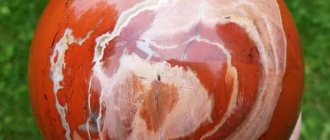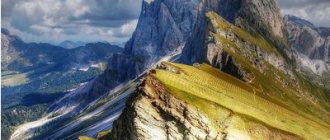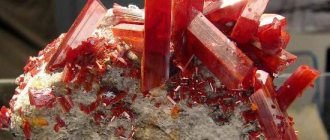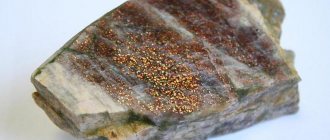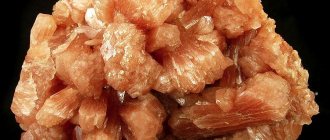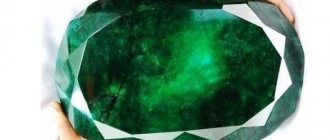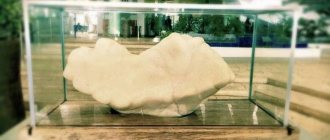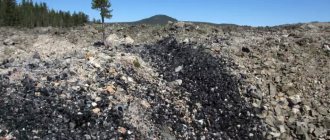Gypsum
- mineral, hydrous calcium sulfate. The fibrous variety of gypsum is called selenite, and the granular variety is called alabaster. One of the most common minerals; the term is also used to designate the rocks it consists of. Gypsum is also commonly called a building material obtained by partial dehydration and grinding of the mineral. The name comes from the Greek. gypsos, which in ancient times meant both plaster itself and chalk. A dense snow-white, cream or pink fine-grained variety of gypsum known as alabaster
- Structure
- Properties
- Morphology
- Origin
- Application
- Classification
- Physical properties
- Optical properties
- Crystallographic properties
See also:
Ice
– structure and physical properties
What is gypsum
For most people, plaster is a hard, opaque grayish substance that is placed on a broken arm or leg in the hospital.
However, the description of the natural mineral is richer:
- It can be half or completely transparent, translucent, even luminous.
- Gloss – pearlescent, glassy, silky, matte.
- More often it is presented as a tabular agglomerate or crystals - columns, prisms, needles.
The mineral cannot be dissolved by most acids, but water has no problem.
This characteristic of gypsum is unique: solubility with water is maximum at 37.8°, after which it tends to zero.
Physico-chemical characteristics
According to chemical nomenclature, the mineral gypsum is aqueous calcium sulfate. The international classification defines the mineral class as sulfates.
Its composition is complex, the formula is multi-component.
| Formula | CaSO4 2H2O |
| Color | White, shades of gray and red |
| Stroke color | White |
| Shine | Glass to pearlescent |
| Hardness | 1,5—2,0 |
| Cleavage | Very perfect |
| Kink | Uneven; flexible but not elastic |
| Density | 2.2—2.4 g/cm³ |
| singonia | Monoclinic |
| Refractive index | 1,52 |
Place of Birth
Sedimentary origin ensured the widespread occurrence of the rock on the planet:
- Russian deposits are concentrated in the North Caucasus, in the vicinity of the Urals, Krasnodar Territory, Tatarstan, and Dagestan.
- The largest suppliers of raw materials to the world market are the USA, Canada, Spain, Iran, and Turkey.
Some mines are unique. For example, in Oklahoma. This US state has an array of natural gypsum formations - the Alabaster Caves park with raw materials of white, pink and rare black color. However, they extract it there in crumbs.
ORIGIN
A widespread mineral, it is formed in natural conditions in various ways. The origin is sedimentary (typical marine chemogenic sediment), low-temperature hydrothermal, found in karst caves and solfataras. Precipitates from sulfate-rich aqueous solutions during the drying out of sea lagoons and salt lakes. Forms layers, layers and lenses among sedimentary rocks, often in association with anhydrite, halite, celestine, native sulfur, sometimes with bitumen and oil. It is deposited in significant quantities by sedimentation in lake and sea salt-bearing dying pools. In this case, gypsum, along with NaCl, can be released only in the initial stages of evaporation, when the concentration of other dissolved salts is not yet high. When a certain concentration of salts, in particular NaCl and especially MgCl2, is reached, anhydrite will crystallize instead of gypsum and then other, more soluble salts, i.e. The gypsum in these basins must belong to earlier chemical sediments. Indeed, in many salt deposits, layers of gypsum (as well as anhydrite), interbedded with layers of rock salt, are located in the lower parts of the deposits and in some cases are underlain only by chemically precipitated limestones.
In Russia, thick gypsum-bearing strata of Permian age are distributed throughout the Western Urals, in Bashkiria and Tatarstan, in Arkhangelsk, Vologda, Gorky and other regions. Numerous deposits of Upper Jurassic age are established in the North. Caucasus, Dagestan. Remarkable collection samples with gypsum crystals are known from the Gaurdak deposit (Turkmenistan) and other deposits in Central Asia (in Tajikistan and Uzbekistan), in the Middle Volga region, in the Jurassic clays of the Kaluga region. In the thermal caves of Naica Mine, (Mexico), druses of uniquely sized gypsum crystals up to 11 m long were found.
Varieties of mineral
Depending on the structure, density, and other characteristics, several types of gypsum are distinguished:
- Alabaster. The whitest mineral of high purity. Among the Greeks, the term αλαβαστρος meant “white.” Formed when gypsum is heated to 142°C.
- Selenite. A colorless variety of fibrous structure with a silky sheen. Found a century and a half ago in the Urals. Named due to the radiance that seems to emanate from within the stone. Based on this characteristic, it can be easily distinguished from other types of gypsum.
In Russia it is known as “Maryino glass”. The history of the name is connected with the tradition of covering the faces of saints, especially the Mother of God (Virgin Mary), with transparent selenite plates.
- Desert Rose. Plaster plates of pastel shades, assembled in the shape of a rosebud. Found in the deserts of Africa.
- Crystal. Not a particularly durable mineral with grayish tints. Goes for souvenirs.
- Anhydride. Dehydrated gypsum in the form of crystals (sometimes very large). Looks like marble. It is easy to distinguish the origin by placing the sample in a humid microclimate. The plaster will gradually swell and become deformed.
Mineral Anhydride
There is a classification of the mineral according to the speed of setting (fast-, medium-, slow-hardening gypsum).
MORPHOLOGY
Crystals, due to the predominant development of {010} faces, have a tabular, rarely columnar or prismatic appearance. Of the prisms, the most common are {110} and {111}, sometimes {120}, etc. The faces {110} and {010} often have vertical shading. Fusion twins are common and come in two types: 1) Gallic by (100) and 2) Parisian by (101). It is not always easy to distinguish them from each other. Both of them resemble a dovetail. Gallic twins are characterized by the fact that the edges of the prism m {110} are located parallel to the twin plane, and the edges of the prism l {111} form a reentrant angle, while in Parisian twins the edges of the prism I {111} are parallel to the twin seam. It occurs in the form of colorless or white crystals and their intergrowths, sometimes colored by inclusions and impurities captured by them during growth in brown, blue, yellow or red tones. Characteristic are intergrowths in the form of a “rose” and twins – the so-called. “swallowtails”). It forms veinlets of a parallel-fibrous structure (selenite) in clayey sedimentary rocks, as well as dense, continuous fine-grained aggregates resembling marble (alabaster). Sometimes in the form of earthy aggregates and cryptocrystalline masses. Also makes up the cement of sandstones. Pseudomorphoses of calcite, aragonite, malachite, quartz, etc. on gypsum are common, as are pseudomorphs of gypsum on other minerals.
Where is it used?
The scope of application of gypsum is limitless. Each uses the right type of raw material.
Application areas
This is an inexpensive, practical material for cement, slabs, blocks, cornices. Suitable for interior or exterior.
Alabaster is important as a raw material in the production of special grades of paper, enamels, paints, glazes, and medical compositions.
The substandard material is ground and turned into a soil desalinizer.
Aesthetics
Sculptors cannot work without plaster blanks.
Master stone carvers turn stone into small plastic pieces, vases, and boxes.
Colorless transparent selenites are especially in demand. Stone cutters transform mysteriously shimmering pebbles into small plastic pieces, an esoteric assortment: pyramids, balls, pendulums.
Selenite bracelet
Jewelers create cabochons.
However, the fragility of the mineral limits the range. These are mainly pendants, pendants, brooches - things that do not risk quickly wearing out or crumbling.
Collecting
You can collect the “gypsum section” of a mineralogical collection for years, the manifestations and forms of the mineral are so diverse.
Connoisseurs are especially interested in “desert rose”, “Maryino glass”, black and pink stones from America, “dovetail”, samples with the cat’s eye effect.
Maryino glass
Application
Gypsum is suitable for making dental impressions (dentistry). Sculptural plaster is used in the manufacture of outdoor sculptures and interior items (vases, table tops, souvenirs).
Interesting: during the war in the United States, Oscar statuettes, the highest cinema award, were made not of metal, but of plaster. After the war, these awards were replaced with traditional metal ones (a gold-plated alloy of tin and lead).
The mineral is used to produce:
- Construction mixtures (plaster, putty, self-leveling floors).
- Gypsum concrete, drywall.
- Decorative stone, imitation marble.
- Part of Portland cement.
- Ammonium sulfate (fertilizer).
- High grade writing paper (as filler).
- As a flux in nickel smelting.
The use of the mineral as a marble simulator in the production of facing slabs is due to the properties of gypsum. These are high decorative qualities, the ability to be easily polished and processed.
Educational: the blocks of the Cheops pyramid are held together with gypsum mortar.
How to care
Plaster is strong, but vulnerable, so you need to care for it carefully:
- Avoid falls, impacts, and mechanical impact.
- Protect stones from the harsh sun (especially alabaster, which quickly turns yellow and fades).
- Do not place products in rooms with consistently high humidity (bathtub, swimming pool, open veranda, greenhouse).
A humid microclimate is detrimental to gypsum: the mineral becomes saturated with water, losing its shape and decorativeness.
Contaminants are removed from the stone with a dry or slightly damp cloth.
It is useful to recharge the selenite variety of the mineral with the light of the Moon by placing it on the windowsill at night.
Flaws
There are no building materials without flaws. In calcium dihydrate (gypsum), they are mainly associated with water:
- Hygroscopicity. Due to their porous structure, mineral raw materials absorb large amounts of water. This property limits the use of building gypsum in damp environments.
- Low moisture resistance. As a result of getting wet, there is a high probability of deformation of the product or building.
- Corrosion of metal reinforcement laid inside building blocks. Therefore, for the reinforcement of buildings it is better to use natural fibrous materials - wood, reeds, etc.
- Low strength. Side effect of porous structure. Gypsum coating is easy to scratch, and sometimes you don’t even need tools to do it.
Moisture resistance can be improved using filler additives. They can be lime, oleic acid, clay, granulated blast furnace slag, a mixture of soluble glass and dextrin. Another option is to apply finishing coatings to the finished product to prevent water from entering the pores.
Therapeutic effect
The healing properties of gypsum are recognized by lithotherapists and official medicine.
Medical science uses the mineral in the following areas:
- Treatment of broken bones or sprained ligaments.
- Regulation of sweating.
- Cleansing the skin and body in general. There is no mysticism - this is the merit of calcium and sulfur in the composition of the mineral. They are the ones who draw out toxins, impurities, and clean pores.
Lithotherapists recommend the mineral to patients with spinal tuberculosis and osteomyelitis. The pebble is applied to any sore spot.
For a physically healthy person, the mineral is suitable as a sedative. Contemplating a ball or stone for a few minutes a day calms you down, helps you concentrate, and overcome apathy, depression, and anger.
From Antiquity to the present day
The history of a simple stone goes back to antiquity. Pliny has many descriptions of the types of alabaster and the places of its extraction. In the scientist's works this mineral is called alabastrites. It was used in construction, for the manufacture of vessels, lamps, and sarcophagi.
In Egypt, a relief from the tomb of the ruler of the Hermopolis nome Thutihotep depicts the transportation of a statue of this ruler sitting on a throne: according to the inscription, this statue is approx. 6.50 m, was made of Hatnub alabaster.
Alabaster vessels were considered the best for storing incense.
Magic properties
The magical effect of gypsum is ambiguous:
- The stone calms the boiling of passions. A figurine or mineralogical specimen is suitable for hot-tempered, nervous people as a sedative.
The magic of gypsum attracts prosperity, love, money to the owner.
- The crystalline variety of the mineral neutralizes the negative effects of gadgets. It is recommended to place a product made from it near the computer screen.
- The mineral does not suppress a person’s will, but it is not needed by suggestible, insecure people: under its influence, these qualities will intensify.
- The stone is capable of destroying the Napoleonic plans of proud, vain, stubborn, aggressive people.
It is advised to place it in the bedroom so that the marriage remains strong.
Preparing for Application or Forming
Mixing with water, semi-aqueous gypsum again becomes dihydrous. The question arises: why then are drying and grinding needed if in the end everything returns to the beginning? The fact is that after processing, the fine-crystalline structure of the material becomes more uniform, and its porosity decreases. Products made from such raw materials are stronger and more durable than those made from unprocessed ones.
To obtain a working solution (test), the powder is carefully poured into water in small portions, stirring continuously. Proportions are calculated based on the purity of the raw materials, grinding fineness, and water temperature. Often information about recommended proportions can be found on the packaging, but how to dilute building gypsum if there is no such information?
In such cases, the average formula applies: you need to take 1 part of the dry mixture and 1 or 1.25 parts of water. The result will be a moderately thick dough suitable for most jobs. The less water, the denser and stronger the product will be. The amount of liquid is reduced with the help of special additives: it can be lime with glucose or molasses, sulfite-alcohol stillage, etc.
Dilution of building gypsum
Dilution of building gypsum
The finished mixture is used immediately after preparation. Repeated stirring of a mixture that has begun to set will not make it suitable for work - on the contrary, it will worsen its properties and, after hardening, the surface of the product or plastered wall will quickly begin to crack and collapse. Attempts to “refresh” the finished mixture by adding water or a new portion of powder will lead to the same results.

